DRUNK DRIVING
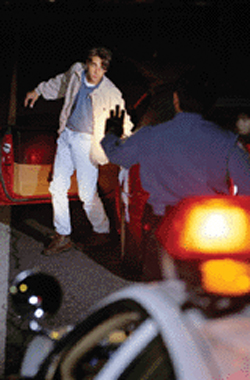
THE TOPIC
Alcohol is a major factor in traffic accidents. The U.S. Department of Transportation, National Highway Traffic Safety Admininstration (NHTSA, http://www.nhtsa.dot.gov) estimates that there is an alcohol-related traffic fatality every 30 minutes.
Alcohol-related crashes are defined as those where someone involved, either a driver or a pedestrian or another nonoccupant, had a traceable amount of alcohol in his or her blood. According to NHTSA, 17,602 people died in alcohol-related crashes in 2006, the highest level since 1996 and up 0.1 percent from 17,590 in 2005. Alcohol was involved in 41 percent of all crash fatalities in 2006.
The Federal Bureau of Investigation estimates that 1.5 million drivers were arrested for driving under the influence of alcohol or narcotics in 2006. The arrest rate works out to one arrest for every 137 licensed drivers in the United States, based on 2005 licensed drivers.
The definition of drunk driving is consistent throughout the United States. Every state and the District of Columbia defines impairment as driving with a BAC (blood alcohol content) at or above 0.08. In addition, they all have zero tolerance laws prohibiting drivers under the age of 21 from drinking and driving. Generally the BAC in these cases is 0.02.
Antidrunk driving campaigns especially target drivers under the age of 21, repeat offenders and 21 to 34-year-olds, the age group that is responsible for more alcohol-related fatal crashes than any other. Young drivers are those least responsive to arguments against drunk driving, according to the National Highway Traffic Safety Administration.
To make sellers and servers of liquor more careful about to whom and how they serve drinks, 43 states and the District of Columbia hold liquor servers legally liable for the damage and injuries a drunk driver causes.
RECENT DEVELOPMENTS
-
Drunk Driving by Age: According to data from the National Highway Traffic Safety Administration (NHTSA), the number of people ages 16 to 20 who were killed in crashes involving a drunk driver or motorcycle operator (with a BAC of 0.08 or higher) rose 3.9 percent in 2006, compared with 2005. Among 21 to 34 year olds, the number of fatalities rose 0.7 percent for the same period. Fatalities dropped for all other age groups during this period.
-
A handful of states are considering lowering the drinking age to allow people as young as 18 years old to legally purchase alcohol.
In Vermont a bill that would authorize a task force to examine the issue of lowering the drinking age and make recommendations to the state legislature in 2009 was passed by a Senate committee.
In South Carolina, Kentucky and Wisconsin lawmakers have proposed allowing under-21 active duty military personnel to buy alcohol.
A South Dakota lawyer has proposed an initiative to allow 19- and 20-year olds to purchase certain low alcohol beer, and a Missouri group will use the Internet to gather signatures to get a measure on the ballot that would lower the drinking age to 18. Groups such as the Mothers Against Drunk Driving have opposed this movement.
NHTSA reports that 890 lives were saved by the minimum drinking age laws in 2006. Since 2002 more than 4,500 lives have been saved by these laws. Supporters of lower drinking ages say that the current laws do not prevent younger people from consuming alcohol but rather drive consumption underground, especially on college campuses.
-
Enacting administrative license revocation laws (which allow on-the-spot drivers license suspension if the driver’s BAC is over the legal limit or if the driver refuses to take a BAC test) and reducing the definition of drunk driving to 0.08 BAC have reduced crashes, according to research from the University of Minnesota and the University of New South Wales, Australia.
By comparing monthly crash statistics for three years before and after these laws were put into effect, researchers found that administrative revocation laws reduced single-vehicle nighttime crashes by almost 11 percent. These crashes are often associated with alcohol-impaired driving. Lowering the BAC level to 0.08 resulted in a 5 percent reduction in singlevehicle nighttime crashes.
-
The Safe, Accountable, Flexible and Efficient Transportation Equity Act—the 2005 federal highway funding bill signed by the president in August 2005—includes funding incentives for states that pass laws that target three types of drunk drivers: repeat offenders, drivers with BACs over 0.15 (“higher-risk drunk drivers”) and drunk drivers whose licenses were previously revoked for drunk driving. It also withholds a certain percentage of funding from states that do not have an open container law (one that prohibits at least the driver of a car from having an open container of alcohol in the passenger compartment of a motor vehicle).
Among the more serious penalties included for convicted higher-risk drunk drivers are license revocation, vehicle impoundment and use of ignition interlocks (devices that prevent a vehicle from starting if the breath of the driver contains any alcohol).
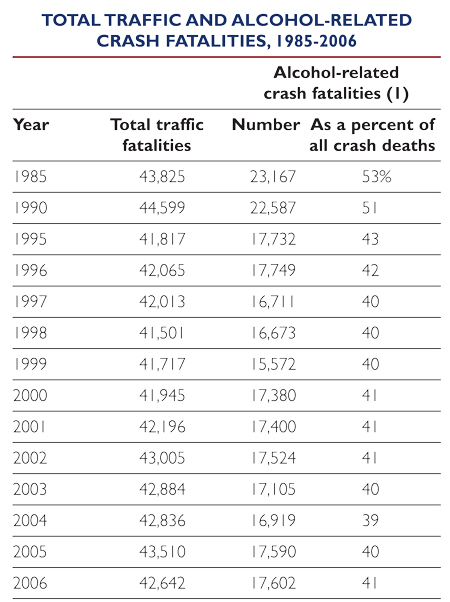
(1) Crashes are alcohol-related if either a driver or a pedestrian had a blood alcohol content (BAC) of 0.01 or greater in a police-reported accident. All states use 0.08 as the definition of intoxication.
Source: U.S. Department of Transportation, National Highway Traffic Safety Administration.
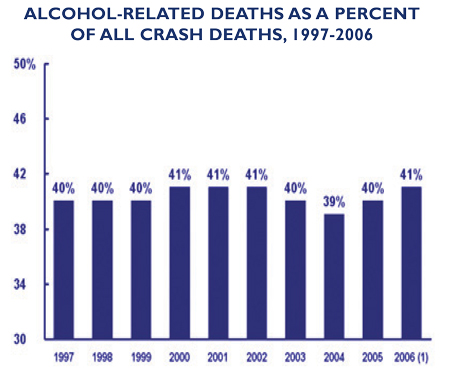
(1) Projected.
Source: U.S. Department of Transportation, National Highway Traffic Safety Administration.
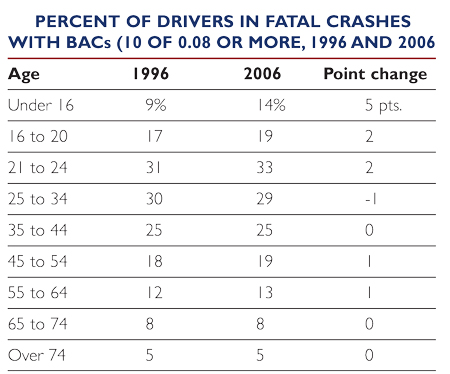
(1) Blood-alcohol content. All states use 0.08 as the definition of intoxication.
Source: U.S. Department of Transportation, National Highway Traffic Safety Administration.
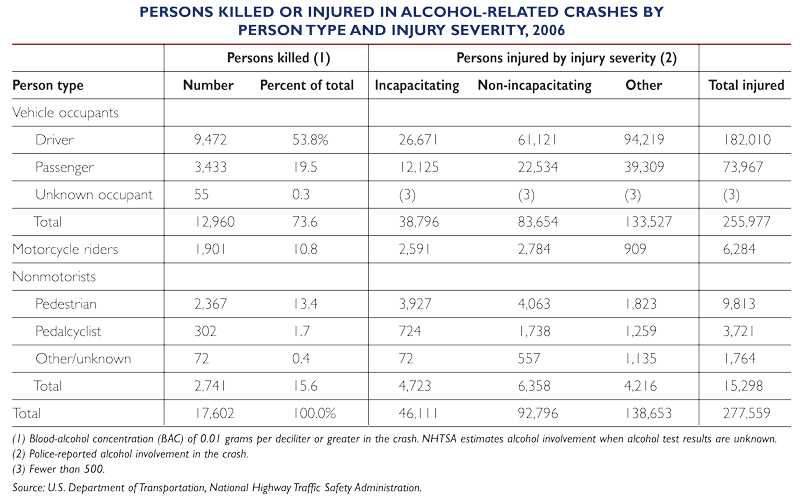

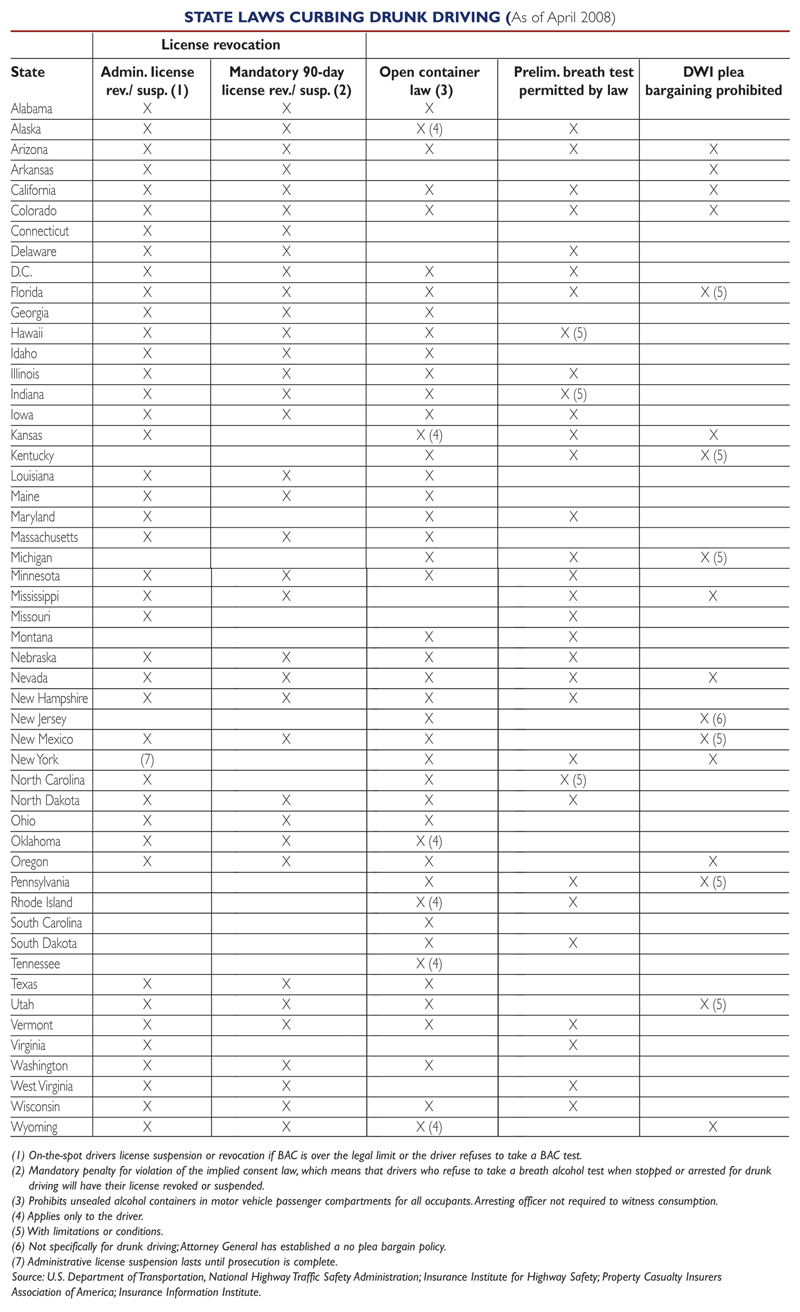
BACKGROUND
Awareness of the problems associated with drunk driving increased dramatically in the 1990s in response to the rise of citizen activist groups, notably Mothers Against Drunk Drivers (MADD), and to advertising campaigns and publicity efforts by organizations such as the Insurance Information Institute. Existing laws were strengthened, new laws were passed and drunk driving task forces were created in several states. In addition, there was a noticeable change in attitudes toward drinking and driving.
In 1984 Congress enacted legislation that required highway construction funds to be withheld from states that did not adopt 21 as the legal drinking age for alcoholic beverages. By 1988 all states had signed laws raising their drinking age to 21.
The same concept of using financial incentives to persuade states to enact drunk driving laws was incorporated in the Omnibus Drug Initiative Act of 1988 (also called the Drunk Driving Prevention Act), which helped to increase the adoption of the administrative license revocation law (ALR). This law allows a driver's license to be seized when his or her BAC (blood alcohol content) is over the level that defines driving while intoxicated or when the driver refuses to take a BAC test. It has been shown to be one of the most effective deterrent to drunk driving.
Other laws enacted include those that prohibit open alcoholic beverage containers in the passenger compartments of motor vehicles, make BAC tests mandatory for drivers involved in serious or fatal accidents, prevent drivers under 21 from obtaining alcohol and provide for vehicle registration cancellation when drivers have had their licenses suspended or revoked due to alcohol-related offenses.
The 1991 Surface Transportation Efficiency Act mandated that states had to pass four out of five laws that were recognized as having the greatest effect on drunk driving: ALR laws; lowering the legal BAC limit to 0.08 percent; using sobriety checkpoints, which remove drunk drivers from the road immediately and remind other drivers that random checks could occur at any time; establishing effective systems for preventing drivers under 21 from obtaining alcohol; and providing education programs for convicted drunk drivers, funded by the fines assessed against those drivers. Enacting other laws brought additional funds. In 1995 the National Highway Bill further encouraged states to enact the 0.02 BAC level for drivers under 21 by holding back a portion of federal highway funds.
By the late 1990s the campaign against drunk driving focused on lowering the national limit for drunk driving from 0.10 to 0.08 BAC. A Transportation Appropriations Act mandated in 2000 that states that did not enact the 0.08 BAC standard would forfeit highway construction funds. A similar law was enacted in 2001. States that failed to comply by October 2003 lost 2 percent of certain federal highway funds. By July 2004 all states and the District of Columbia had enacted the 0.08 BAC standard.
Drunk driving laws have been frequently tested in court. In 1990, for example, the New Jersey Supreme Court ruled that accused drunk drivers do not have a right to a jury trial. Utah is the only other state to deny jury trials in drunk driving cases. The constitutionality of roadblocks to check driver sobriety was contested in state courts in the 1980s and in 1990 the issue came before the U.S. Supreme Court, which ruled in Michigan vs. Sitz (No.88-1897) that sobriety checkpoints are a valid tool for detecting and apprehending intoxicated drivers and do not violate the Fourth Amendment prohibiting illegal search and seizure. Despite the decision, roadblocks have continued to be opposed in some state courts. Forty-one states plus the District of Columbia permit sobriety checkpoints, according to MADD.
Another important case decided by the U.S. Supreme Court in 1990 was Pennsylvania vs. Muniz (No.89-213), in which the court ruled that videotaped evidence of impaired physical performance by a drunk driver is admissible.
Repeat Offenders: Over half of drivers arrested for drunk driving in the nation are repeat offenders, according to a 2003 AAA Foundation for Traffic Safety study. Two-thirds of drivers with suspended licenses still drive. To combat the problem, the foundation recommended laws that allow the impounding of vehicles, the removal of license plates on arrest, the mandating of ignition interlocks, the use of special plates to identify repeat offenders and the use of checkpoints to verify licenses.
The foundation also recommended prohibiting vehicle registration by drivers without valid licenses. Forty-six states have passed ignition interlock laws, according to MADD. Interlocks are devices that measure a driver's blood alcohol and prevent a car from starting if alcohol is detected.
Liability Issues: Commercial servers: Forty-three states and the District of Columbia have laws on the books or case law (law that comes about through a court ruling rather than an act of the legislature) that hold commercial servers of alcohol liable for the harm caused by their intoxicated patrons. Some of the laws have limitations.
In August 2004 the Supreme Court of the State of Washington (which has case law holding commercial servers of alcohol liable) ruled that alcohol servers can be held liable if they serve "apparently" intoxicated patrons. In the past the standard was "obviously" intoxicated. At the same time, the Kansas Court of Appeals urged the state's Supreme Court to revisit a 19-year-old decision that protects tavern owners from the threat of liability. The appeals court was asked to review the decision in a case filed by a mother who lost a son in a drunk driving crash in 2002.
According to a hospitality industry insurance specialist, although hospitality establishments have instituted risk management techniques to mitigate liquor liability litigation, claims are still a problem. In 2003 two of the 50 largest verdicts were filed against establishments that serve liquor. In one case, in Indiana, a jury awarded $60 million to two plaintiffs injured by a drunk driver who had been served free drinks at a grand opening. In the other case, heard in Georgia, the jury awarded $36 million to the families of two of three teenagers who were killed by a driver who struck their vehicle after being served 10 beers.
Among the recommendations made in the specialist's January 2005 market report were to strictly measure the amounts of alcohol served in drinks to discourage “regulars” from frequenting establishments where drinks are stronger, encouraging drinking establishment employees to report any accidents that may involve the establishment and conducting thorough post-accident investigation.
Social Hosts: Thirty-three states have enacted laws or have case law that permit social hosts who serve liquor to people who subsequently are involved in crashes to be held liable for any injury or death. These laws may have limited application, for example, many laws specify that the drinker must be obviously intoxicated. In some cases, the laws are only targeted at minors.
KEY SOURCES OF ADDITIONAL INFORMATION
"Traffic Safety Facts, Alcohol," U.S. Department of Transportation, The National Center for Statistics and Analysis, NHTSA, annual issues.
Mothers Against Drunk Driving (MADD), http://www.madd.org.
© Insurance Information Institute, Inc. - ALL RIGHTS RESERVED
© 2015 TLC Magazine Online, Inc. |